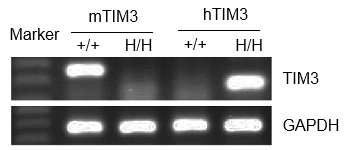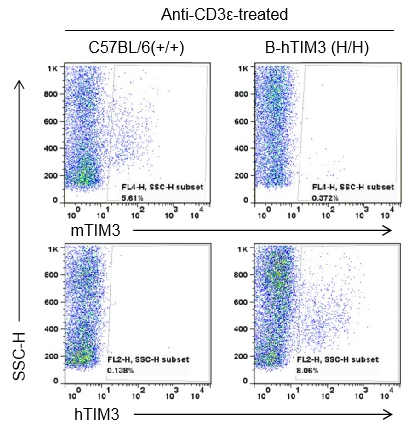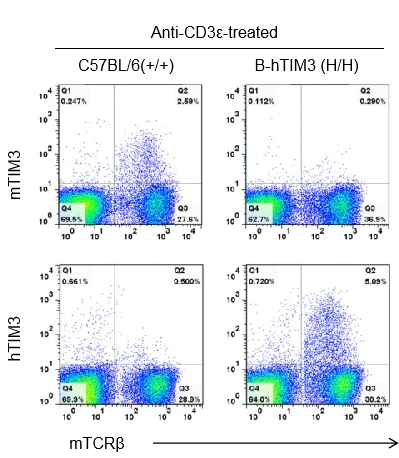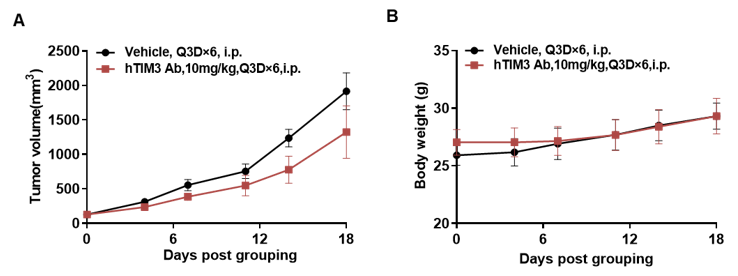 Targeting strategy
Targeting strategy
Gene targeting strategy for B-hTIM3 mice. The exon 2 of mouse Tim3 gene that encode the Ig-like V-type domain were replaced by human TIM3 exon 2 in B-hTIM3 mice.
 mRNA expression analysis
mRNA expression analysis
Strain specific analysis of TIM3 gene expression in WT and hTIM3 mice by RT-PCR. Mouse Tim3 mRNA was detectable in splenocytes of wild-type (+/+) mice. Human TIM3 mRNA was detectable only in H/H but not in +/+ mice.
 Protein expression analysis
Protein expression analysis
Strain specific TIM3 expression analysis in homozygous B-hTIM3 mice by flow cytometry. Cells in ascites were collected from WT and homozygous B-hTIM3 (H/H) mice stimulated with anti-CD3ε in vivo, and analyzed by flow cytometry with species-specific anti-TIM3 antibody. Mouse Tim3 was exclusively detectable in non-T and non-B cells from WT mice. Human TIM3 was exclusively detectable in non-T and non-B cells from homozygous B-hTIM3 but not WT mice.
Strain specific TIM3 expression analysis in homozygous B-hTIM3 mice by flow cytometry. Splenocytes were collected from WT and homozygous B-hTIM3 (H/H) mice stimulated with anti-CD3ε in vivo, and analyzed by flow cytometry with species-specific anti-TIM3 antibody. Mouse Tim3 was exclusively detectable in WT mice. Human TIM3 were exclusively detectable in homozygous B-hTIM3 but not WT mice.
 In vivo efficacy of anti-human TIM3 antibodies
In vivo efficacy of anti-human TIM3 antibodies
Antitumor activity of anti-human TIM3 antibodies in B-hTIM3 mice. (A) Anti-human TIM3 antibodies inhibited MC38 tumor growth in B-hTIM3 mice. Murine colon cancer MC38 cells were subcutaneously implanted into homozygous B-hTIM3 mice (male, 7 week-old, n=5). Mice were grouped when tumor volume reached approximately 100 mm3, at which time they were treated with anti-human TIM3 antibody with doses and schedules indicated in panel A. (B) Body weight changes during treatment. As shown in panel A, anti-human TIM3 antibody was efficacious in controlling tumor growth in B-hTIM3 mice, demonstrating that the B-hTIM3 mice provide a powerful preclinical model for in vivo evaluation of anti-human TIM3 antibodies. Values are expressed as mean ± SEM.
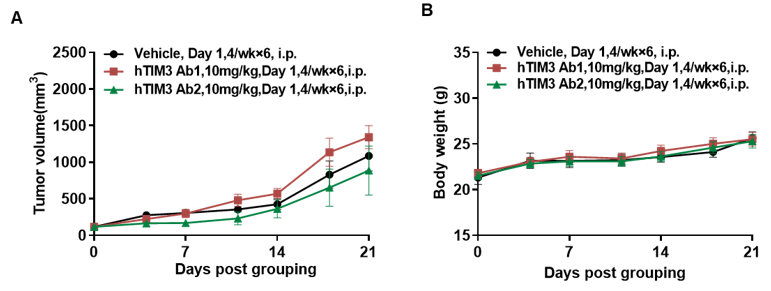
Antitumor activity of anti-human TIM3 antibodies in B-hTIM3 mice. (A) Anti-human TIM3 antibodies inhibited MC38 tumor growth in B-hTIM3 mice. Murine colon cancer MC38 cells were subcutaneously implanted into homozygous B-hTIM3 mice (female, 4 week-old, n=5). Mice were grouped when tumor volume reached approximately 100 mm3, at which time they were treated with two anti-human TIM3 antibodies with doses and schedules indicated in panel (B) Body weight changes during treatment. As shown in panel A, anti-human TIM3 Ab2 was efficacious in controlling tumor growth in B-hTIM3 mice, demonstrating that the B-hTIM3 mice provide a powerful preclinical model for in vivo evaluation of anti-human TIM3 antibodies. Values are expressed as mean ± SEM



